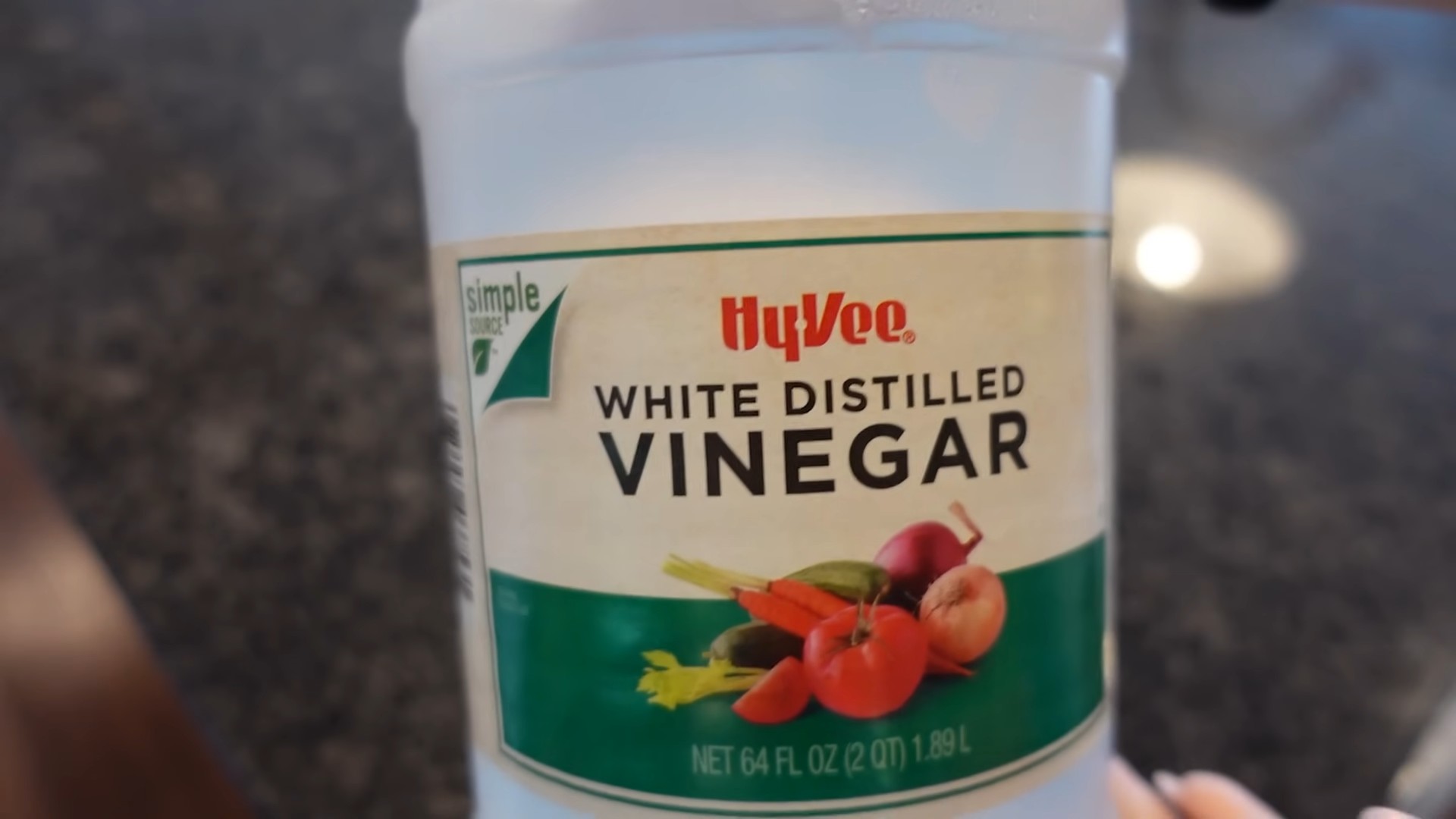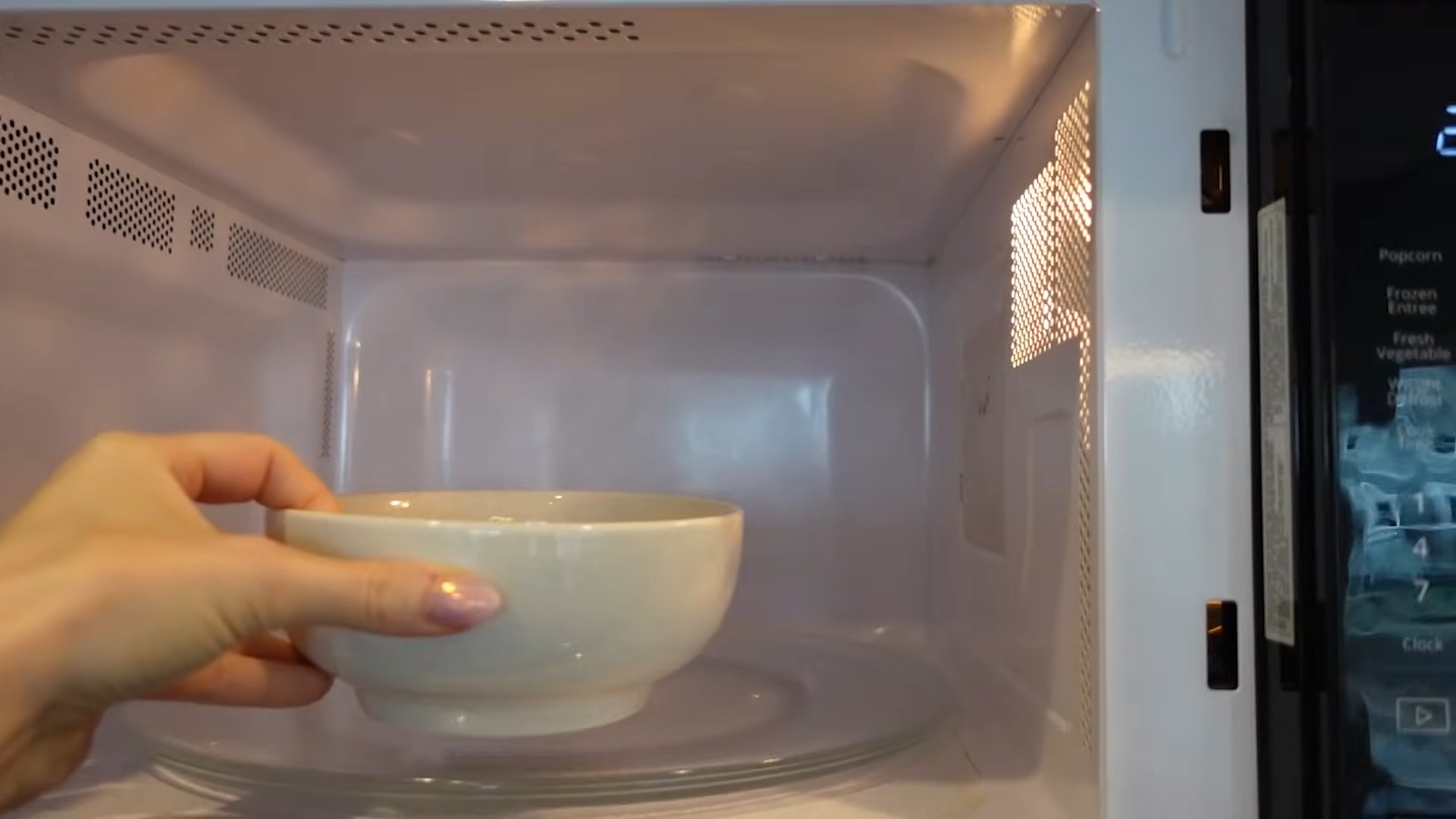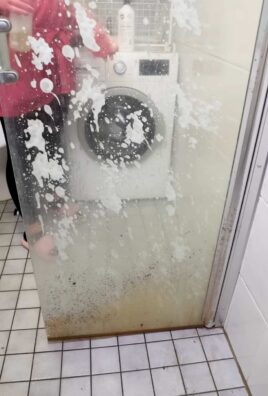Microwave cleaning vinegar steam – sounds like a science experiment, right? Well, it’s actually one of the easiest and most effective DIY tricks I’ve discovered for keeping my kitchen sparkling! Let’s be honest, the microwave is a culinary workhorse, but it often suffers from splatters, spills, and that lingering “mystery food” aroma.
For generations, vinegar has been a go-to cleaning agent. Our grandmothers swore by it, and for good reason! Its natural acidity cuts through grease and grime without the harsh chemicals found in many commercial cleaners. Think of it as a time-tested, eco-friendly solution passed down through the ages.
Why do you need this microwave cleaning vinegar steam trick in your life? Because nobody wants to spend hours scrubbing baked-on food! This method softens even the most stubborn messes, making cleanup a breeze. Plus, it’s a fantastic way to deodorize your microwave, leaving it fresh and ready for your next culinary adventure. I’m excited to share this simple yet powerful hack that will save you time and effort, leaving you with a sparkling clean microwave and more time to enjoy the things you love!

DIY Microwave Cleaning with Vinegar Steam: A Sparkling Clean in Minutes!
Hey everyone! Let’s face it, cleaning the microwave is one of those chores we all dread. But what if I told you there’s a super easy, natural way to get it sparkling clean without harsh chemicals or endless scrubbing? That’s right, we’re going to use the power of vinegar steam! This method is not only effective but also incredibly budget-friendly. I’ve been using this trick for years, and it’s saved me so much time and effort. So, grab your vinegar, and let’s get started!
What You’ll Need:
Before we dive in, let’s gather our supplies. The beauty of this hack is that you probably already have everything you need!
* A microwave-safe bowl (glass or ceramic works best)
* White vinegar (the star of the show!)
* Water
* A clean sponge or cloth
* Oven mitts or pot holders (for safety!)
The Magic of Vinegar Steam: Why It Works
Vinegar is a natural cleaning powerhouse. Its acidity helps to loosen dried-on food splatters and grime, making them much easier to wipe away. The steam created in the microwave helps to penetrate even the toughest messes, softening them from the inside out. Plus, vinegar is a natural deodorizer, so it will leave your microwave smelling fresh and clean!
Step-by-Step Guide: Cleaning Your Microwave with Vinegar Steam
Okay, let’s get down to business! Follow these simple steps, and you’ll have a spotless microwave in no time.
1. Prepare the Vinegar Solution: Fill your microwave-safe bowl with 1 cup of water. Then, add 2 tablespoons of white vinegar. Don’t worry about the vinegar smell; it will dissipate quickly. I usually use a measuring cup to make sure I get the right proportions, but eyeballing it works too!
2. Microwave the Solution: Place the bowl in your microwave. Now, here’s the key: microwave the solution on high for 3-5 minutes. You want the water to boil and create a good amount of steam. The exact time will depend on your microwave’s power, so keep an eye on it. I usually start with 3 minutes and add more time if needed.
3. Let the Steam Work Its Magic: Once the timer goes off, DO NOT OPEN THE MICROWAVE DOOR IMMEDIATELY! This is crucial. Let the bowl sit inside the microwave for another 5-10 minutes. This allows the steam to fully saturate the interior and loosen all the grime. I usually use this time to do other chores or grab a cup of coffee.
4. Carefully Remove the Bowl: After the steaming period, carefully remove the bowl from the microwave using oven mitts or pot holders. The bowl and the water will be very hot, so be extra cautious. I always double-check to make sure I have a good grip before taking it out.
5. Wipe Down the Interior: Now comes the satisfying part! Using your clean sponge or cloth, wipe down the interior of the microwave. You’ll be amazed at how easily the loosened food splatters come off. Pay special attention to the top, sides, and bottom of the microwave. I like to start at the top and work my way down to avoid dripping.
6. Clean the Turntable and Roller Ring: Remove the turntable and roller ring from the microwave. Wash them with warm, soapy water. These parts tend to accumulate a lot of grease and grime, so give them a good scrub. Rinse them thoroughly and dry them before placing them back in the microwave. I sometimes put the turntable in the dishwasher for an even deeper clean.
7. Wipe Down the Exterior: Don’t forget the outside of the microwave! Use your damp sponge or cloth to wipe down the exterior, including the door, handle, and control panel. This will remove any fingerprints, smudges, and spills. I like to use a separate cloth for the exterior to avoid transferring any grime from the inside.
8. Dry and Admire: Finally, use a clean, dry cloth to dry the interior and exterior of the microwave. This will prevent water spots and leave your microwave looking sparkling clean. Step back and admire your handiwork!
Troubleshooting and Tips for Success
Even with the simplest DIY projects, things don’t always go perfectly. Here are some tips and solutions to common issues you might encounter:
* Stubborn Stains: If you have some particularly stubborn stains that won’t come off with just wiping, try making a paste of baking soda and water. Apply the paste to the stain, let it sit for a few minutes, and then scrub gently with a sponge. The baking soda will act as a mild abrasive to help remove the stain.
* Lingering Vinegar Smell: While vinegar is a great cleaner, some people find the smell a bit strong. If the vinegar smell lingers after cleaning, simply leave the microwave door open for a few hours to air it out. You can also place a small bowl of baking soda inside the microwave overnight to absorb any remaining odors.
* Microwave Not Steaming Enough: If your microwave isn’t producing enough steam, try increasing the microwaving time by a minute or two. You can also add a bit more vinegar to the solution. Just be careful not to overdo it, as too much vinegar can damage some microwave components.
* Preventative Measures: To keep your microwave clean for longer, try covering your food with a microwave-safe lid or plastic wrap when heating it up. This will prevent splatters and spills from accumulating inside the microwave. Also, try to wipe up any spills as soon as they happen to prevent them from drying and becoming harder to remove.
Safety First!
Before I forget, let’s talk about safety. Working with hot liquids and appliances requires caution.
* Always use oven mitts or pot holders when handling the hot bowl of vinegar solution.
* Be careful when opening the microwave door after steaming, as the steam can be very hot.
* Never microwave metal objects in the microwave.
* Unplug the microwave before cleaning the exterior if you’re using a damp cloth.
Alternative Cleaning Solutions (If You’re Not a Vinegar Fan)
While I’m a huge fan of the vinegar method, I understand that some people might prefer other cleaning solutions. Here are a few alternatives you can try:
* Lemon Juice: Lemon juice is another natural cleaner that works similarly to vinegar. Simply replace the vinegar with lemon juice in the recipe above. The lemon juice will also leave your microwave smelling fresh and citrusy.
* Baking Soda: You can also use baking soda to clean your microwave. Mix a few tablespoons of baking soda with water to create a paste. Apply the paste to the interior of the microwave, let it sit for a few minutes, and then wipe it clean with a damp sponge.
* Commercial Microwave Cleaners: If you prefer to use a commercial microwave cleaner, be sure to choose one that is non-toxic and safe for use around food. Follow the instructions on the product label carefully.
Maintaining a Clean Microwave: A Few Extra Tips
Keeping your microwave clean doesn’t have to be a daunting task. Here are a few simple habits you can adopt to maintain a clean microwave:
* Wipe up spills immediately: As I mentioned earlier, wiping up spills as soon as they happen is the best way to prevent them from drying and becoming harder to remove. Keep a sponge or cloth handy near the microwave for quick cleanups.
* Cover your food: Using a microwave-safe lid or plastic wrap to cover your food will prevent splatters and spills from accumulating inside the microwave.
* Regularly clean the turntable and roller ring: The turntable and roller ring tend to accumulate a lot of grease and grime, so it’s important to clean them regularly. I usually wash them once a week.
* Do a quick steam clean once a month: Even if you’re diligent about wiping up spills, it’s still a good idea to do a quick steam clean once a month to keep your microwave fresh and clean.
Final Thoughts
So there you have it! A simple, effective, and natural way to clean your microwave using the power of vinegar steam. I hope you found this guide helpful. Give it a try, and let me know how it works for you! Happy cleaning!

Conclusion
So, there you have it! This simple, yet incredibly effective, microwave cleaning vinegar steam method is a game-changer for anyone who wants a sparkling clean microwave without harsh chemicals or endless scrubbing. We’ve all been there, staring into the abyss of splattered food and wondering how it got so bad. But with just vinegar and water, you can transform that mess into a pristine cooking space in minutes.
Why is this a must-try? Because it’s fast, it’s cheap, it’s eco-friendly, and it works! Forget those expensive microwave cleaners filled with questionable ingredients. This method harnesses the natural power of steam and vinegar to loosen grime and grease, making it incredibly easy to wipe away. Plus, the vinegar helps to neutralize odors, leaving your microwave smelling fresh and clean.
Looking for variations? You can add a few drops of lemon or orange essential oil to the vinegar and water mixture for an extra burst of freshness. If you have particularly stubborn stains, try adding a tablespoon of baking soda to the water before microwaving. For a deeper clean, after steaming, let the vinegar water sit in the microwave for 10-15 minutes before wiping. This allows the vinegar to further penetrate and loosen any remaining grime. You can also use a lemon instead of vinegar. Cut a lemon in half, squeeze the juice into the water, and then place the lemon halves in the bowl before microwaving. The lemon’s citric acid works similarly to vinegar, providing a fresh, citrusy scent.
This microwave cleaning vinegar steam trick is a true kitchen essential. It’s a simple solution to a common problem, and it’s a method you’ll find yourself using again and again.
We’re confident that once you try this method, you’ll be amazed by the results. It’s a quick and easy way to maintain a clean and hygienic microwave, ensuring that your food is always cooked in a safe and healthy environment.
Don’t just take our word for it – give it a try! We encourage you to experiment with the variations and find what works best for you. And most importantly, we want to hear about your experience. Share your before-and-after photos, your tips and tricks, and your overall thoughts on this microwave cleaning vinegar steam method in the comments below. Let’s create a community of sparkling clean microwaves! We are eager to hear your feedback and learn from your experiences. Your insights will help others discover the magic of this simple cleaning solution. So, grab your vinegar, water, and a microwave-safe bowl, and get ready to say goodbye to microwave messes forever!
Frequently Asked Questions (FAQ)
1. What type of vinegar should I use for microwave cleaning?
White vinegar is the most effective and commonly recommended type of vinegar for cleaning. Its high acidity helps to break down grease and grime effectively. However, you can also use apple cider vinegar if that’s what you have on hand. While it might have a slightly less potent scent, it will still work well for cleaning your microwave. Avoid using flavored vinegars, as they may leave unwanted residue or scents in your microwave.
2. How much vinegar and water should I use?
A good starting point is a 1:1 ratio of vinegar to water. For example, you can use 1/2 cup of vinegar and 1/2 cup of water in a microwave-safe bowl. If your microwave is particularly dirty, you can increase the amount of vinegar slightly. However, avoid using too much vinegar, as the strong scent can linger.
3. How long should I microwave the vinegar and water mixture?
Microwave the mixture on high for 3-5 minutes, or until the solution comes to a rolling boil and the microwave window is steamy. The exact time will depend on the power of your microwave. Keep a close eye on it to prevent the mixture from boiling over.
4. Is the vinegar smell going to be overpowering?
The vinegar smell can be noticeable, but it shouldn’t be overpowering. The steam helps to dissipate the scent quickly. If you’re sensitive to smells, you can open a window or turn on the exhaust fan while microwaving. Adding a few drops of essential oil, like lemon or orange, to the mixture can also help to mask the vinegar smell. The smell will dissipate quickly after you wipe down the microwave.
5. What if the grime is still stuck after steaming?
If some grime remains after steaming, let the vinegar water sit in the microwave for an additional 10-15 minutes before wiping. This allows the vinegar to further penetrate and loosen the stubborn stains. You can also use a non-abrasive sponge or cloth to gently scrub away any remaining residue. For particularly tough spots, try making a paste of baking soda and water and applying it directly to the stain before wiping.
6. Can I use this method on all types of microwaves?
Yes, this method is generally safe for all types of microwaves. However, it’s always a good idea to check your microwave’s user manual for any specific cleaning instructions or warnings. Ensure that the bowl you use is microwave-safe to prevent any accidents.
7. How often should I clean my microwave using this method?
The frequency of cleaning depends on how often you use your microwave and how messy it gets. As a general guideline, cleaning your microwave every 1-2 weeks is a good practice to maintain a clean and hygienic cooking environment. If you notice spills or splatters, it’s best to clean them up immediately to prevent them from hardening and becoming more difficult to remove later.
8. What if I don’t have vinegar? Can I use something else?
If you don’t have vinegar, you can use lemon juice as an alternative. Cut a lemon in half, squeeze the juice into the water, and then place the lemon halves in the bowl before microwaving. The lemon’s citric acid works similarly to vinegar, providing a fresh, citrusy scent. You can also use a commercial microwave cleaner, but be sure to choose one that is non-toxic and safe for food contact surfaces.
9. Is it safe to use a metal bowl in the microwave for this method?
No, it is not safe to use a metal bowl in the microwave. Metal can cause sparks and potentially damage your microwave. Always use a microwave-safe glass or plastic bowl for this method.
10. Can I use this method to clean the outside of my microwave?
While this method is primarily designed for cleaning the inside of your microwave, you can use a diluted vinegar solution to clean the outside as well. Mix equal parts vinegar and water in a spray bottle, spray it onto a clean cloth, and wipe down the exterior surfaces of your microwave. Avoid spraying the solution directly into the vents or electronic components.




Leave a Comment